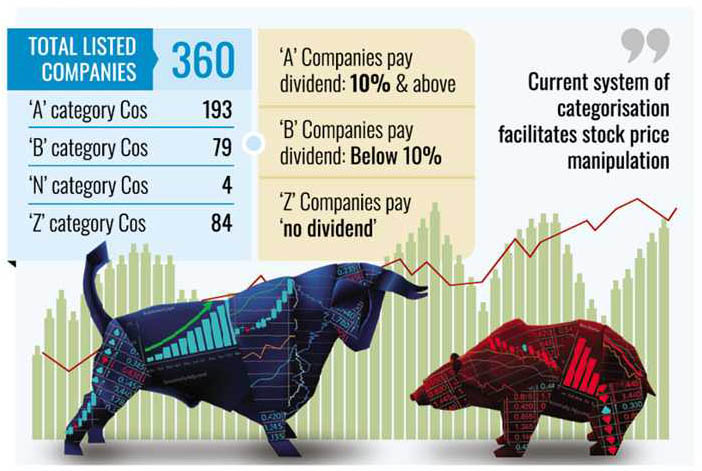
Classification of listed companies
Experts urge performance-based categorisation
Mohammad Mufazzal | Sunday, 29 September 2024
Experts suggest that the current system for categorising listed companies solely based on dividends should be revised to better reflect their business performance.
They recommend categorising companies based on their performance and the size of capital, as the existing system linked to credit facilities contributes to market volatility.
Under the current system, a company is classified as 'A' if it distributes at least 10 per cent dividends while the companies issue dividends less than 10 per cent fall into the 'B' category.
Both 'A' and 'B' category companies are downgraded to the 'Z' category if they do not issue any dividends.
Unlike the existing system, neighbouring and emerging markets do not categorise listed companies solely based on dividends. Bourses in those countries, including India, classify companies based on performance, size, and other factors such as liquidity and financial strength.

Deshan Pushparajah, Country Head of CAL Bangladesh, a joint-venture foreign brokerage firm in Bangladesh, described the categorisation of companies based on dividends as "unnecessary."
CAL Group is a leading Frontier Markets Investment Bank based in the UAE with its roots in Sri Lanka.
Mr Pushparajah noted that there is no listing category in Sri Lanka, and a company's trading can remain "suspended" due to serious non-compliance issues.
In Sri Lanka, trading is suspended even if a company's auditor issues a qualified opinion due to flaws in the financial statements, he said.
But in Bangladesh, the current listing categorisation does not accurately reflect companies' true performances. Instead, it creates scope for companies with poor fundamentals to be grouped with strong companies, including multinational corporations that adhere to global accounting standards.
Besides, any sudden downgrade of a listed company by the Dhaka and Chittagong Stock Exchanges creates market volatility.
For instance, a total of 28 listed companies were downgraded from the 'B' category to the junk 'Z' category on Wednesday. The reasons: half of these companies failed to distribute at least 80 per cent of their approved dividends, while the others did not recommend dividends for two consecutive years.
The following day, these companies hit the lower limit of the circuit breaker, leaving a negative impact on the broad index.
Despite having weak fundamentals, many of the 28 companies previously retained their 'B' category status alongside fundamentally strong firms.
For example, before distributing 10 per cent cash for the calendar year 2023, the multinational company Robi Axiata was classified as a 'B' category company, sharing this status with Zaheen Spinning. However, Zaheen Spinning distributed only a 0.25 percent cash dividend, resulting in its classification alongside Robi despite their vastly different fundamentals.
Robi Axiata's accounting standards are far better than those of Zaheen Spinning, which received a qualified opinion from its auditor due to discrepancies in its financial statements.
Many other companies that have also received qualified opinions have managed to retain at least a 'B' category status in the country's capital market by distributing only nominal dividends.
Md. Ashequr Rahman, managing director of Midway Securities, described the current listing categorisation as completely "irrational," noting its connection to credit facilities.
"This system creates multiple problems, including abnormal price hikes in the market," he said.
He pointed out that investors usually do not purchase strong stocks like Grameenphone using margin loans, yet many invest in junk stocks that qualify for marginable categories just by issuing nominal dividends.
He suggested that companies should be categorised as large-cap, mid-cap, and small-cap. "This categorisation could be based on their capital sizes, so that investors can get an idea about the volume of a company's free float shares," Rahman explained.
Why do companies try to avoid
the 'Z' category?
Companies try to avoid the 'Z' category for several reasons:
Firstly, investors are prohibited from obtaining margin loans for investments in 'Z' category stocks, which deters investment in these securities.
Secondly, the trading cycle for junk shares is T+3, while it is T+2 for 'A', 'B', and 'N' category stocks. Investors prefer the shorter cycle of the latter, as they want to keep their money rolling.
And the third advantage is netting facility which is available for other stock categories but not for junk stocks. Netting facility allows investors to purchase new stocks immediately after selling other stocks.
Md. Moniruzzaman, managing director of Prime Bank Securities, said that the categorisation of companies solely based on dividends ultimately does not benefit investors.
Rather, such system of categorisation facilitates stock price manipulation in the market, he added.
An investor gets dividends based on the face value of their shares, not on the market price of the shares.
As a result, a cash dividend of 10 per cent or more from a company with a stock price above Tk 1,000 adds little to investors' portfolios.
"The categorisation of companies based on dividends would matter if dividend yields were taken into account," Mr. Moniruzzaman explained.
The nominal dividends recommended by struggling companies to maintain their marginable status also do not benefit investors.
For instance, Legacy Footwear and C & A Textile proposed cash dividends of 0.50 per cent and 0.40 per cent, respectively, for FY23.
By purchasing a share of Legacy Footwear before the record date at Tk 82.70, a shareholder received a cash dividend of only Tk 0.05. Meanwhile, a cash payment of Tk 0.04 per share allowed C & A Textile to upgrade its status from the 'Z' category to the 'B' category.
mufazzal.fe@gmail.com